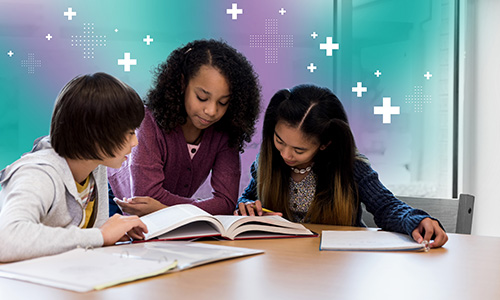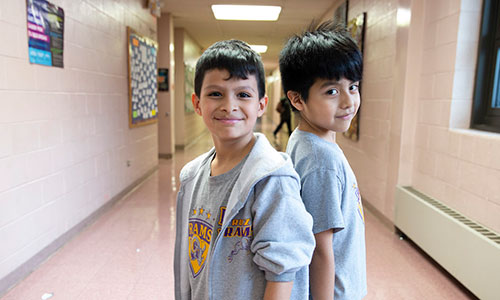
When we at NWEA released a document sharing our views on writing instruction last September, we were excited about the innovations happening with digital literacy. We even discussed a body of supporting research devoted to digital writing: “Reading is a rapidly evolving experience in the digital world,” we acknowledged. “Readers must be savvy consumers of digital and multimodal texts.”
Then, two months later, OpenAI released ChatGPT, and teachers’ worlds turned upside down.
Initially, there seemed to be a sense of panic. Teacher forums were flooded with valid concerns about how students could use ChatGPT to cheat on written assignments. Some school districts even took steps to ban it. However, as the use cases for AI became more apparent, that sense of panic has started to shift to, “Okay, ChatGPT is here to stay. How can I leverage it to improve my students’ learning?”
My experiments with ChatGPT
When I first started brainstorming for this blog post with a colleague, I honestly didn’t know where I stood on AI, or what exactly I was going to write about. Each time I thought of an example of AI’s potential instructional utility, I immediately followed up with an example of its potential dangers. My colleague remarked, “Lauren, you keep contradicting yourself. I’m not sure you actually know what you believe about this tool.” Ouch. But she was right.
On one hand, I know that AI applications like ChatGPT have become common in the workplace, and the internet is inundated with various AI tools. I want students to be prepared to use the technology effectively and responsibly. On the other hand, I know that the process of writing facilitates critical thinking. We don’t always know what we think about a topic until we start writing about it. New thoughts and connections come to us as we write. This blog post itself is an example! If students rely too much on a chatbot to write for them, they could miss out on vital critical-thinking experiences.
Faced with this dilemma, I decided to go directly to the source: I asked ChatGPT to help me write this post. A few curious things happened.
My first prompt was “Write a 1,000 word blog post on the benefits of using ChatGPT in the classroom.” ChatGTP suggested teachers could use the AI to “develop critical-thinking skills,” “offer personalized feedback,” and “enhance creativity by examining different perspectives.” Great. These all sounded very plausible. However, when I asked it to write a blog post on the dangers of using ChatGPT in the classroom, I got eerily mirrored results. Dangers included “loss of critical-thinking skills,” “diminished interpersonal skills,” and “exposure to biased content.”
So I dug a little deeper. When I asked ChatGPT to provide me specific suggestions, I was able to cull the following promising ideas for instructional benefits:
- Provide differing perspectives on a topic to help students evaluate claims
- Build students’ language skills via sentence expansion and vocabulary activities
- Offer various writing prompts to spark students’ imagination
- Present step-by-step guides
- Offer suggestions for revisions
With these ideas in my toolbox, I went back to ChatGPT to help me make them a reality, with various levels of success.
I asked ChatGPT to write an argumentative essay and told it to include research to support the position. With my first attempt, I only got phrases like “Research shows…,” so I refined my prompt to include parenthetical citations, which ChatGPT then did. However, when I refined it further to include a works cited page, ChatGPT provided some bogus references.
Next I tasked the tool with creating an instructional activity on vocabulary. I got a few really interesting lesson plans, but none of them asked students to use their new vocabulary knowledge in new contexts, a key principle in effective vocabulary instruction.
I directed ChatGPT to draft several ideas for writing prompts for Romeo and Juliet. While all the prompts were on topic, they were also very generic and didn’t necessarily promote synthesis of ideas. I also prompted it to create a step-by-step guide for students on how to create a podcast, but it vastly oversimplified the process for a first-time user.
When I asked it to provide feedback on a piece of writing (which had already gone through copy edit), it rewrote the paragraph but didn’t explain why it was making the changes. I had to try several prompts for it to provide me constructive feedback to consider, instead of automatically rewriting the paragraph.
I’m sure if I continued to tinker with my prompts to the chatbot, I could have gotten better and more precise results, which brings me back to the NWEA document on reading instruction: “readers must be savvy consumers of digital and multimodal texts.” The more I experimented with the technology, the savvier I became at using it.
ChatGPT is just one piece of the digital literacy landscape. As my colleague Laura wrote about in “3 ways to improve students’ digital literacy skills,” students need intentional support with developing digital literacy skills. Thus, I firmly believe that students need access to and support with using chatbot technology, including appropriate guardrails, so they can develop the digital savviness needed to use it effectively, efficiently, and responsibly.
How to responsibly integrate ChatGPT into your classroom
Based on my interactions with ChatGPT and my research of the broader conversation around its use, I recommend the following strategies for using it with your students.
1. Set classroom norms on the use of ChatGPT
Spend time discussing the different use cases for ChatGPT with your students, as well as the pros and cons of each. Invite students to coconstruct the norms with you. Perhaps your norms will involve using the technology only to generate ideas or produce outlines, not drafts, or require the inclusion of ChatGPT as a coauthor when appropriate.
For more on norming, read “The science behind classroom norming.”
2. Establish a baseline of students’ writing skills
Before online plagiarism programs were invented, many attuned teachers could catch cases of plagiarism because they knew when a piece of writing didn’t sound like a student.
Make sure to provide students the opportunity to write without the assistance of ChatGPT. This might look like assigning personal narratives or writing with pen and paper. Read those pieces of writing, provide students feedback, and keep a record of them in each student’s writing portfolio.
At the end of the year, you might even ask students to reflect on how using ChatGPT helped or hindered their writing development, using examples from their portfolio.
3. Help students evaluate the credibility of arguments and the effectiveness of language choices
When given good prompts, ChatGPT can quickly produce models of writing for students to critique.
You might use the AI to provide students with the opportunity to examine alternate perspectives on a topic or to illustrate how word choice and syntax can affect tone. You can also use it to help students understand the criteria of your writing rubrics by having students assess how well ChatGPT meets the expectations of a rubric category. This can be especially useful when trying to showcase the formulaic features of AI writing versus the authentic voice of human writing. You can even ask students to manually revise ChatGPT’s writing to reflect a more unique style and voice.
4. Augment your lesson plans
If your students need help with writing more complex sentences, ChatGPT can quickly produce a list of sentences for students to expand. If your students need background knowledge on a topic to access a more challenging (and authentic) complex text on it, ChatGPT can produce a primer on the topic. It can also translate texts into different languages for your multilingual students, and it can create a variety of tailored graphic organizers to assist students with organizing their ideas.
But remember: ChatGPT is not an expert on pedagogy or content. It is a generative language model that is trained on vast quantities of openly available online writing, which include both research-based information as well as blatant misinformation. Teachers should evaluate its suggestions carefully for accuracy.
5. Model its use with students
Just as teachers should model the writing process in front of students, they should also model how they use ChatGPT. This might look like setting specific goals for using the tool (e.g., idea generation, feedback), trying different prompts to obtain more precise responses, fact-checking content, or choosing which feedback to apply and which to disregard.
Hearing you “think aloud” as you use the tool is an invaluable experience for students.
Keep learning
The suggestions above just barely scratch the surface. The AI landscape is rapidly evolving, and as more advanced versions of ChatGPT (we are on version four as of this publication) and other AI tools are released, we will need to continuously reexamine how we use them.
Even ChatGPT makes this statement about itself: “It’s important to note that while ChatGPT can be a valuable tool, it should not replace human interaction entirely. It’s crucial to establish clear boundaries and ensure that critical or sensitive tasks are handled by human professionals when necessary.” I can personally attest to this experience. ChatGPT gave me a launching pad for ideas for this blog post that I could then explore further based on my knowledge and experience as an educator.
For more information on the ongoing debate, check out these resources:
- “Suspicion, cheating, and bans: AI hits America’s schools”: In this episode of the podcast The Daily, journalists interview students and teachers on how ChatGPT is changing education.
- “Pivoting the conversation on AI in writing”: In this article, Central Michigan University professor Troy Hicks explores how we can rethink our current writing assignments in light of ChatGPT.
- “6 ways to use ChatGPT to save time”: This Edutopia article offers teachers tips for using AI efficiently.
- “19 ways to use ChatGPT in your classroom”: This EdWeek post offers additional ways to use ChatGPT in your classroom.
- “Lessons and tools for teaching about artificial intelligence”: This curated list from Common Sense Education includes free instructional resources.







